The Best Thing at CES - Intel's Wireless HD Technology
by Anand Lal Shimpi on January 7, 2010 4:30 PM EST- Posted in
- Trade Shows
Ok, I'm pretty sure I just saw the coolest thing at CES. The eReaders, Smartbooks, eReader Netbooks, etc... are neat but I haven't seen anything I'd actually like to buy yet. Even Microsoft's Slate PC announcement was a disappointment. But this next thing is pretty sweet.

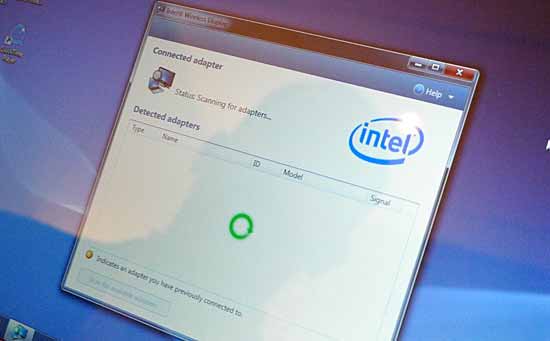
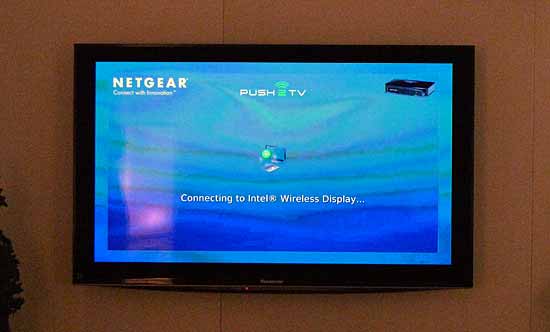
It's called Intel Wireless HD technology and it works like this. Press a button on your notebook and within a matter of seconds the notebook will wirelessly send its display over to your TV.

The communication happens via 802.11n and requires a receiving box hooked up to your TV. Your screen is sent compressed and up/downscaled to 720p, regardless of source resolution. The box is super tiny as it's basically a decoder chip and HDMI output.
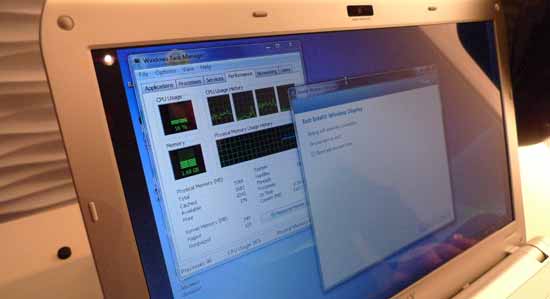
CPU utilization on a Core i5 540M is basically around 15 - 20% while you're streaming your desktop to a TV (all of the compression is done on the CPU). Streaming YouTube HD only took about 5Mbps of network bandwidth. It looked quite good and I didn't see any noticeable compression artifacts. The latter may appear for higher bitrate content or on very large TVs, but for browsing the web, using applications, watching Hulu and most other video it more than works. Intel just killed the reason for most of the Boxee-like devices I've seen at CES. And it's only the beginning.

Intel calls it a game changer. I call it the best thing I've seen at CES.
It basically means that you can walk around with your notebook and put Hulu, YouTube, your desktop apps or games on your TV at the push of a button. Currently the wireless link doesn't support HDCP so it won't send Blu-ray video wirelessly, but everything else works. The first generation only supports a 720p output (your desktop res can be whatever, the software automatically compresses and scales the output on the fly). The next generation of the technology will support 1080p and eventually we'll have HDCP support as well.
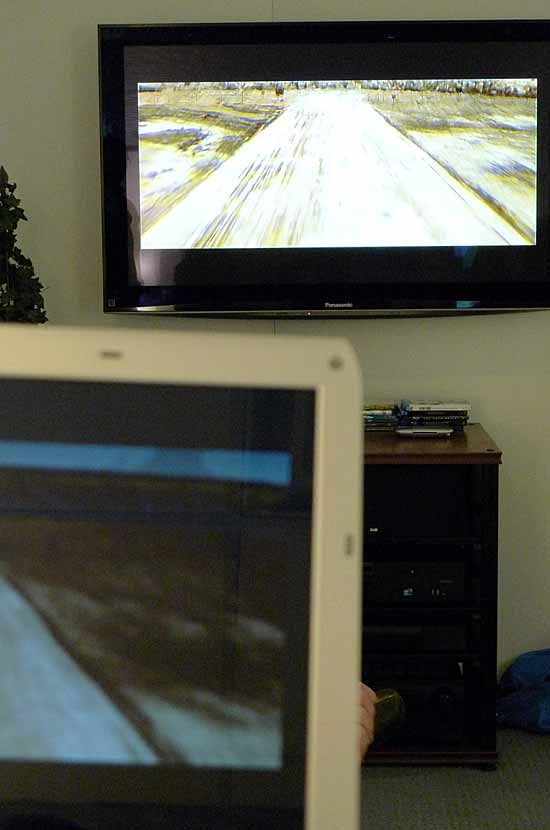
The receiver box is currently only made by Netgear and will ship bundled with three notebooks starting January 17th at Bestbuy. Additional Intel Wireless HD receivers will retail for $99. Intel showed us a demo on a Sony notebook but I believe Dell and Lenovo will also support the technology.
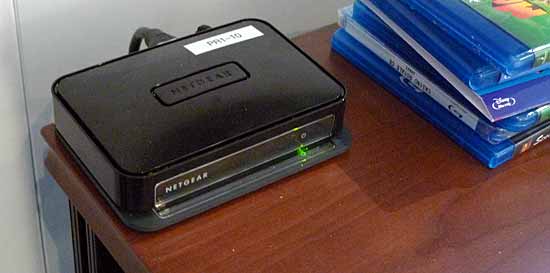
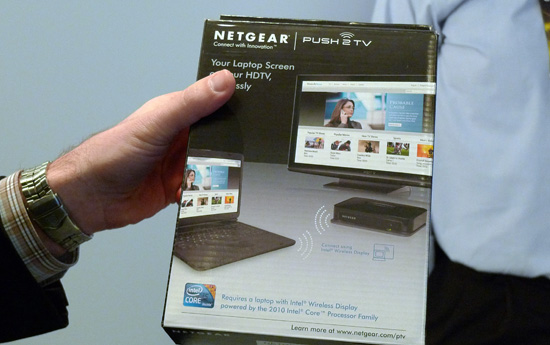
The demo worked flawlessly when I saw it. I hate to keep saying this but it just worked. It's amazingly Apple-like to be honest. It's something I definitely want on my next notebook.










55 Comments
View All Comments
marcusvgarcia - Friday, January 8, 2010 - link
I still don't see anything special.I have a wireless vga adapter purchased last year, it works GREAT...there are even versions that send sound too (i took the one that only sends HD video).
It works flawlessly...and the ONLY reason it has a "dongle" connected on the laptop too is because you still don't see manu wireless USB (WUSB) devices around...as soon as laptops start coming with wireless usb (should be soon) even the dongle would not be necessary anymore.
sprockkets - Friday, January 8, 2010 - link
Wireless USB is dead, I hope you know that.chizow - Thursday, January 7, 2010 - link
Ya I think the "one-touch" button and "Apple-like" functionality out of the box on a PC is the takeaway here. With the nightmare that is DRM, HDCP, Blu-Ray playback, 1080p and lossless audio support on the PC I guess the importance of seamless compatibility and support shouldn't be taken too lightly. Spend some time setting up an Auzen X-Fi HT HD and you'll know what I'm talking about.I agree with you though, if it managed to support all of the features I listed above wirelessly with the touch of a button I'd be Wow'd but as it is now it seems like Intel is doing more of the same from the last few years: trying to convince the general public 1080p is overrated and 720p is really, just fine. /laugh.
Hacp - Thursday, January 7, 2010 - link
This is big, it is huge. I can imagine all sorts of applications for this technology, especially if they come out with a dedicated encoder for this to work with netbooks.Imagine your science/math/engineering professors recording their lectures(all those hour long proofs) on their tablet pcs while transmitting it to the projector with this wireless technology. All this is recorded via camstudio or a similar program. When everything is said and done, they post the lecture on blackboard for all students to download and study from!
straubs - Friday, January 8, 2010 - link
Uh, you don't need wireless to do that. Schools have connections for the projector where the prof is standing anyway!MrDrinkingLysol - Thursday, January 7, 2010 - link
"Your screen is sent compressed and up/downscaled to 720p"In the age of Blu-Ray, anything less than 1080p is useless.
apocryphal - Thursday, January 7, 2010 - link
PS MaxiVista will do 1080p today.AS I alluded to in my post, full screen bluray will stutter. Not sure if this is processor or network bandwidth or both.
chizow - Thursday, January 7, 2010 - link
I've always read from more interested parties that the biggest limiting factor for wireless streamed video was bandwidth and you start running into some of these issues even with HDMI. The compression makes sense here, and the wireless connection makes it simple enough, but the technology doesn't seem to be all that ground-breaking.Couldn't similar be accomplished with a network capable HDTV with a built-in decoder? Seems like more and more HDTVs and receivers are becoming network capable, just include a decoder or light-weight processer capable of doing the decoding. Use Powerline network adapters from a wireless router to the HDTV and stream video from not just your laptop, but any PC attached to the network. After that it just seems like software support to make it all work.
Seems like a good option I suppose for business travelers/presenters or those who rely more on a laptop for their computing needs, but for people who still maintain performance desktops, built HTPCs or use something like a Ion-based Revo, it just doesn't seem all that spectacular.
bobjones32 - Thursday, January 7, 2010 - link
This might not be a mainstream scenario, but I'd love to be able to use this wireless receiver box on my desktop. Right now, the only solution I have is to run a 50+ foot HDMI cable from my PC to my TV, but having this box would negate the need to do that.I wonder if someone from Anandtech could check to see if this box could be used for that?
apocryphal - Thursday, January 7, 2010 - link
I already have this functionality and more between my media center PC and MaxiVista. http://www.maxivista.com">http://www.maxivista.comGranted cost of entry for a media center pc is probably more than this box but you get alot more as well. With the Dell Zino HD ringing at <$250 I'd say its worth it just to go the Media Center PC route. Plus you can have this tech now
Either way I presume your laptop has to have some virtual display driver installed and minimal linux and some vnc like app is running on the box.
I think blu ray is out for now because quality compression in real time would be too process expensive. As processors and wireless technology improve, though thats probably a matter of time. Video cards might be able to offload some of the compression as well.
This is less like innovation and more like corporate muscle getting behind a good idea seen elewhere. I hope MaxiVista and VNC are seeing some money on this but I doubt it.
Being able to do this with an unlimited number of screens ( maxivista limits to 3 currently I believe), would be ideal in a corporate environment.
You could have truly cabless conference rooms and any person could take over the display if need be (the way this sort of thing is currently implemented.) tie this in with existing web conferencing and you have quite a teleconferencing solution.